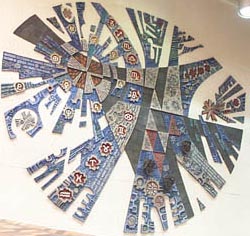
Le poète dans l'univers, mural by Pannier, Lauda, and Cordeau, Crémazie station

Mural by Robert La Palme, Berri-UQAM station
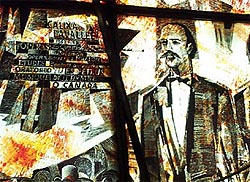
Histoire de la musique à Montréal, stained glass by Frédéric Back, Place-des-Arts station

Montreal Scenes Circa 1830, stained glass by Nicholas Sollogoub, McGill station
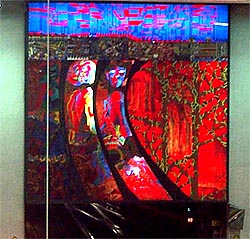
Hommage aux fondateurs de la ville de Montréal, stained glass by Gaboriau & Osterrath, Berri-UQAM station
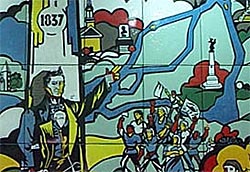
Les Patriotes de 1837-1838, mural by George Juhasz and Jean Cartier, Papineau station
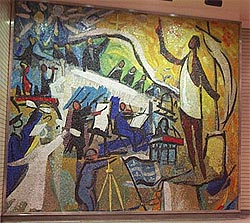
Mosaic by Vau and Bastien, Sherbrooke station
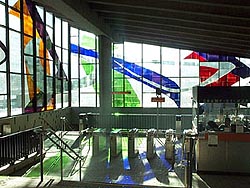
Stained-glass window by Marcelle Ferron, Champ-de-Mars station

Ceramic circles by Jean-Paul Mousseau, Peel station

Citius, Altius, Fortius, mural by Jordi Bonet, Pie-IX station

Coloured forms by Michèle Tremblay-Gillon, LaSalle station
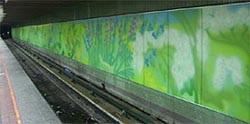
Les quatre saisons – Été by Claude Guité, Snowdon station

Pic et Pelle, sculptures by Germain Bergeron, Monk station
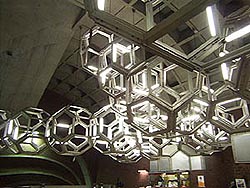
Système, installation by Pierre Granche, Namur station
|
WORKS OF ART IN THE MONTREAL METRO
Benoît Clairoux
Translated by Matthew McLauchlin
The art of Montreal's metro is a fascinating subject. It's often said that Montreal's is one of the most, if not the most, beautiful metro systems in the world. Even without aesthetic judgments, it is certainly true that Montreal showed the way for many other cities, such as Brussels, which followed our lead with great success (if you find yourself in that city someday, a visit to its metro is highly recommended). It's also often said that every metro station in Montreal is different, and each one is decorated; this is not quite the case. Even today, several stations from the first network are still awaiting their artwork. In regards to artwork, the metro underwent two very distinct periods: the initial system and the extensions (1976 and after). Before comparing these two periods, here is a particularly interesting article from 1968:
Thanks to Robert La Palme
Once decorated, the metro will illustrate the life of the city.
The City of Montreal will unveil a giant mural in Crémazie metro station in a few days. The work's theme is literature, but literature in Montreal's history. A business is sponsoring the work, as is the growing fashion in Canada's metropolis.
The metro network's decoration will reach an almost incalculable number of people, taking into account how many people use rapid transit. But it also affects the craftspeople, artists, engineers, civil servants, and media. At the top of the pyramid is one man, Mr. Robert La Palme, a cartoonist by trade but an old hand at the visual arts, who received from the Executive Committee the difficult task of assigning contracts and ensuring that they are executed according to the city's direction.
A knotty disagreement
Mr. La Palme's new task is not making life easy for him. He's had a fist shaken at him by one of the artists set against him. From outside, the disagreement seems knotty and confused, with artists denouncing Mr. La Palme's artistic tastes, or simply angry at him because they have to suit his plans.
But Mr. La Palme has lived through other such quarrels, and they won't distract him from the task at hand: decorating the metro stations with the most beautiful pages from Montreal's history, so that the works will still be as beautiful and as young in 25 and 50 years.
Mr. La Palme's principles are simplicity itself: "We have to distinguish today between creative artists and posers, those showbiz stars who are too often launched, consecrated, and paid in the name of art. I believe that art, even modern art, must return to the human level." In other words, the high priests and snobs of the art world will have no place in the metro.
The chosen artists will be able to create abstract art, but will be discouraged from non-figurative art: "Abstraction is the transposition of the subject by the artist, but in non-figurative art a form is created out of nothing. The danger with this type of art is that the initial surprise wears off."
The artwork in the metro will be as varied as possible, but it will always be understandable; it will always have a meaning for the metro users.
At the moment, only Place-des-Arts station has received an artwork: a stained-glass window donated by the Steinberg company. [Note: three works, including the circles at Peel, had been installed previously when their stations were built.] The second work to be unveiled will soon appear in all its splendour at Crémazie station. The piece represents the poets Crémazie, Nelligan and Saint-Denys Garneau, and was given by the Caisse populaire de Saint-Alphonse d'Youville. The mural is by the ceramist Paul Pannier. However, no project has yet been foreseen for Atwater or Peel. In all of the other stations, there is at least an idea of the work to be done.
Line 1
Guy: Homage to the first seigneurs of Montreal, the Sulpicians and the Grey Nuns. McGill: James McGill, founder of the university, and Peter McGill, second mayor of Montreal, will be honoured here.
Saint-Laurent: A mural will recall the produce growers and the feed and vegetable markets of Montreal.
Berri-de Montigny: The crossroads of the metro is at the heart of Montreal, from where the explorers of North America departed (three stained-glass windows). Another stained-glass window will memorialize the founders of Montreal.
Beaudry: This small station will be devoted to the creative and eccentric elements of the city.
Papineau: The uprisings of 1837, in the style of Epinal: three murals donated by the Society of Artisans.
Frontenac: the arrival of animals at Hochelaga...
Line 2
Henri-Bourassa: in memory of Henri Bourassa, the journalist and the man.
Sauvé: Pilote, the dog who saved the colony several times by alerting her master Lambert Closse.
Jarry: two murals will illustrate the passage from the French to the English regimes and the first charter of Montreal (1833).
Jean-Talon: the arrival of the Filles du Roi; statues of Colbert and Talon.
Beaubien: crossing the island of Montreal over the years from portages to the metro. The humorous work will be by Robert La Palme.
Rosemont: The monarchs who ruled over French Canada (nine French and nine English, plus a French and an English regency).
Laurier: homage to the Charron brothers....
Mont-Royal: this station will be devoted to theatre characters.
Sherbrooke: Mosaics telling the city's economic history: given by the National Fiscal Society and the Saint-Jean-Baptiste Society.
Champ-de-Mars: non-figurative stained-glass window given by the Province of Quebec in memory of Lionel Groulx.
Place-d'Armes: the history of Montreal, sculpted in bas-relief.
Square-Victoria: the world of finance; mosaic on the first Montreal exhibition in 1851.
Bonaventure: On the Place du Canada, invitation to each province to donate a mural; the anthem O Canada at the top of a staircase.
Line 4
Île Sainte-Hélène: On the exterior, the four-flowered flag of Montreal.
Longueuil: Seven monumental sculptures of the Le Moyne brothers.
Source: Le Petit Journal, 25 February 1968
Whose idea was it to integrate art in the Montreal metro? Apparently it was Claude Robillard, director of urban planning of the City of Montreal at the time. As we can see from the above text, other municipal buildings had already enjoyed such a program. But with the metro, nothing less than a huge art gallery was foreseen by Mayor Jean Drapeau and his good friend Robert La Palme. Alas, thirty years later, the vast majority of the works envisioned by La Palme have never seen the light of day. Only McGill ("life in Montreal in the 19th century"), Berri-UQAM (stained-glass window in homage to the founders of the city), Papineau, Sherbrooke ("the accomplishments of the Saint-Jean-Baptiste Society") and Champ-de-Mars (stained-glass window by Marcelle Ferron) followed Place-des-Arts ("the history of music in Montreal") and Crémazie. Even with the Réno-Métro program of recent years, the initial section of the metwork still seems rather depressed. One could even say that the program did more harm than good to metro art — think of the ceramic circles at Peel metro and of how haphazardly they were moved about!
But the idea had been launched, and with the first metro extensions in 1976, art in the metro took on unparalleled dimensions. Sights had been limited until then to sponsored artworks installed years after station inaugurations, due to delays in getting the money. Henceforth, artworks were included in the construction budgets and integrated directly into station architecture. And much to M. La Palme's displeasure, non-figurative art made its appearance in the metro! With time, dozens of new stations were added to the network and spectacular new artworks were unveiled. At LaSalle metro, for example, the whole station could be considered an artwork with its bizarre geometric forms. As in the sixties, some of the greatest local artists were asked to contribute, such as Jordi Bonet for the mural at Pie-IX (superb, but completely ignored by Expo fans!) Jean-Paul Mousseau's influence should also be noted: he signed several works during this period, including at Viau, Honoré-Beaugrand, and Angrignon. But the question remains: when will the ambitious program imagined by Robert La Palme in 1968 be completed? As impressive as it is, the Montreal metro's art gallery nevertheless remains unfinished.
Reproduced by the kind permission of Benoît Clairoux.
Return to the history page
|













